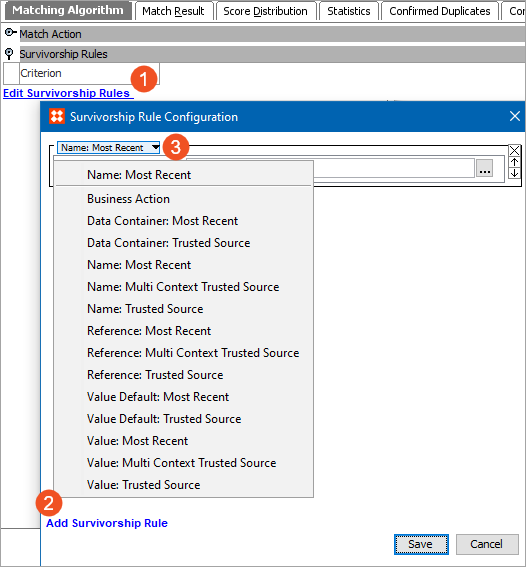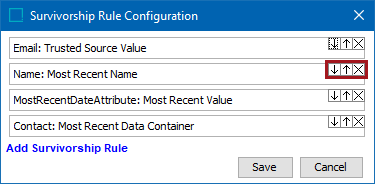Survivorship rules are stored on a matching algorithm and define which source data is added to the golden record for the selected merging or linking solution. For more information, refer to the Golden Records Survivorship Rules topic here.
For details on how to the ensure the most trusted and up-to-date values survive, review the Considerations section below.
Configuration
To configure a survivorship rule:
-
On the Matching Algorithm tab, open the 'Survivorship Rules' flipper and click the Edit Survivorship Rules link.
-
On the 'Survivorship Rule Configuration' dialog, click the Add Survivorship Rule link, and select the required rule from the dropdown.

-
Provide the required parameter information for the selected rule. Parameter details are included in the following topics:
-
Business Action Rule (here)
-
Data Container Rules (here)
-
Name Rules (here)
-
Reference Rules (here)
-
Value Rules (here)
Additionally, for both 'match and link' and 'match and merge' solutions, review the Creating a Merge Keep First Handler topic (here) for directions to override default behavior on the surviving record.
-
-
If necessary, edit the order of the rules which are executed in order from top-to-bottom.
-
Click the down and up buttons to change the order of the rules.
-
Click the X button to remove a rule.

For more information on matching algorithms, refer to the Configuring Matching Algorithms topic here.
Considerations
For most survivorship rules, understanding of the time aspect is important. For Trusted Source, you still need to know which of the values from the most trusted source is the most up-to-date value.
Important: Survivorship on values for Externally Maintained Attributes (here) is not recommended since survivorship logic depends on revision traceability. Externally maintained values may not figure correctly in the traceability view in Web UI, may be survived wrongly, and in some cases, this can lead to errors in survivorship rules when writing the values.
-
Trusted source survivorship rules trust some source systems over others. The rule is configured with a list of the available source systems in the sequence of trust. The systems with lower trust rankings do not overwrite values set by higher trust systems.
Note: Since STEP is considered the ultimate trusted source for trusted source rules, manual edits on a golden record are never overwritten.
The source system information is an integral part of match and merge and is defined in the component model. For more information on how source information is tracked in match and merge, refer to the Match and Merge Traceability topic here.
Important: Information from a source outside the list of trusted sources is regarded as untrusted and as such, that information is not copied to the golden record during trusted source survivorship.
For match and merge trusted source, when the value on a trusted source is deleted:
-
The trusted value is not deleted from the golden record.
-
The value from a lesser trusted source is not applied to the golden record.
-
Values from lesser trusted sources are not available during the survivorship evaluation.
-
-
Most Recent survivorship rule strategy lets the most recent data from all contributing records survive to the final golden record and can be qualified either by the revision date in STEP or by a 'Last Edited' date attribute.
-
Using a 'Last Edited' date attribute makes it possible to promote data based on the time of edit in source systems. For an Attribute Group survivorship rule, the Last Edit Date attribute cannot be part of the attribute group.
-
When no 'Last Edited’ date attribute is selected in a survivorship rule, the STEP revision date is used.
For manual edits, the revision date is always used to determine the most recent value. This logic applies to the object name, attribute values, references, data containers, attribute values on data containers, attribute values on references, and references on data containers.
In the 'Match and Merge Importer' IIEP as well as in the 'Match and Merge Web Service Endpoint,' the deletion of attribute values on existing golden records can be promoted by sending an empty value element in the STEP XML. For example, the following STEPXML would void the 'FirstName' attribute value:
<Value AttributeID=”FirstName”></Value>
-